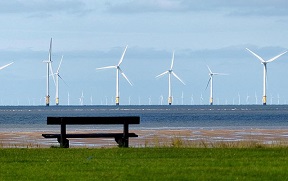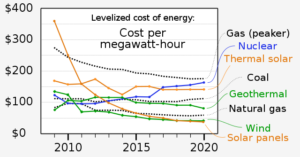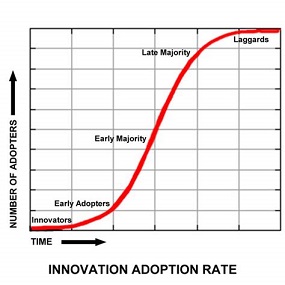Renewable energy continues to grow spectacularly. Investments grow faster than in almost any other economic sector. Prices comes down all the time. It has such a success that a new problem comes to the fore. How do we going to sell this huge amount of dirt-cheap renewable energy?

Supply and demand
In the Netherlands, TNO dealt with the question how supply and demand of renewable energy will look like in 2030. There are major plans for the construction of ever more wind parks in the North Sea; present plans foresee a wind capacity about ten times the present supply. And as more wind turbines are being built, their competition will be fiercer. Causing prices to fall. Companies will have to buy a major share of this renewable energy. TNO foresees a problem of oversupply and a lack of demand. But large-scale electrification is on the horizon already, with the tower-high present gas prices. This prospect will commercial parties to invest less in such wind parks.
And yet, the Netherlands badly need wind parks in the North Sea in order to meet their climate goals by 2030. TNO’s conclusion is that we need to step up efforts for the sale of renewable electricity. So far, policy’s main goal is to increase the production of renewable energy; policy on the demand side is virtually non-existent. The wind sector requires certainty in the demand for its production; in reverse, industry requires that its demand for renewable electricity can be met in the future, if it invests in electrification. Moreover, infrastructure needs to be on par in order to balance supply and demand in the future. Impulses that come with a very fast growing sector.

Towards dirt-cheap renewable energy
We need to deal with these issues now. The substitution of fossil energy by renewable energy implies a complete system change with price dynamics that accompany it. Propelled by the advent of dirt-cheap renewable energy. Have an eye as well on the major projects to come in Saudi Arabia. They do seriously prepare for a future without fossil fuels. Electricity prices in the order of a few cents per kWh are not far-fetched. Yes, the entire energy system will change. Energy storage will play a much more important part. But as renewable energy costs will keep on falling for some time, the price gap with fossil fuels will remain at a level at which we can afford energy storage as well. Nevertheless, it is a good sign that policy now shows concern for the infrastructure required. But ultimately, this will only affect the speed of change, not the transition as such.
Investments in renewable energy have been on the rise for quite some time now. In the Netherlands, energy start-ups collected 10.8 million of venture capital, in 2017 that sum rose to 113 million. And the number of investment rounds rose explosively as well, from 2 in 2012 to 39 in 2017 and 52 in 2018. World-wide we witness the same development: investments in renewable energy rose from 60 billion in 2004 to over 300 billion in 2014, china taking the lead in this development. In 2022 this amount has risen to over 500 billion, if we include infrastructure to 820 billion. World-wide, 70% of all energy investments arte in renewable energy; the remainder is taken up by grids and energy storage. And technological developments still go on. Because of that, we now produce four times as much solar energy per unit of investment as ten years ago.
Society in transition
For industry, one of the major changes will be from natural gas as the energy source to electricity. The Dutch government now concludes agreements with industries willing to make this change. Dow in Terneuzen is one of the first companies expressing the wish to do so. In 2023, we will discover whether supply and demand of renewable electricity still match. Then, the new tender for the next wind park in the North Sea will start, by far the largest park so far. It will provide almost twice the amount of electricity as all wind turbines in the Dutch sector of the North Sea so far.
But one might argue: dirt-cheap renewable energy? Just recently, energy prices have skyrocketed? Yes, the war in Ukraine interrupted the international supply of fossil fuels; these have therefore become much more expensive. But costs of renewable energy keep on falling. Ultimately, the present war will turn out to be a major impulse for solar and wind energy. The price gap between fossil and renewable energy has now become very large indeed. So large in effect that any parties with second thoughts will be convinced; this will fundamentally change the conservative energy sector. About time, the sector missed many opportunities. Why did consumers have to take the lead in installing solar panels? Just to rtake one example?

The S-curve
Renewable energy will ultimately take the course of all new technologies. The start will be slow; but then, technology will have the opportunity to become mature. After that, the breakthrough. In the famous S-curve, developments will take a sharp turn upwards. We are in that phase now. Assisted, in this case, by the madness of Putin’s war. But it is going to happen.
Written together with Alle Bruggink
Interesting? Then also read:
Green energy transition will be cheap
Solar and wind energy: increasing recognition
Cheap energy storage speeds up
